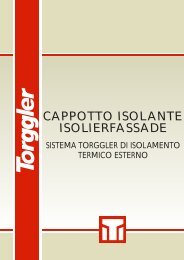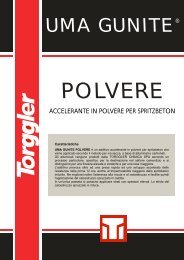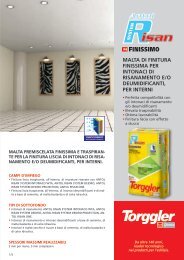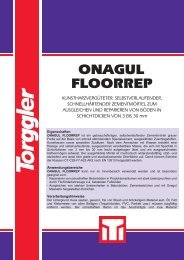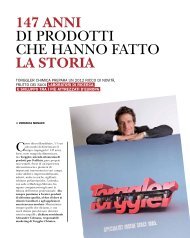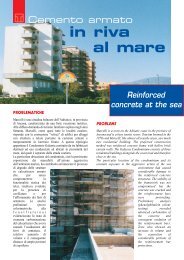Sigillatura Giunti Edificio Industriale a Verona - Torggler
Sigillatura Giunti Edificio Industriale a Verona - Torggler
Sigillatura Giunti Edificio Industriale a Verona - Torggler
Create successful ePaper yourself
Turn your PDF publications into a flip-book with our unique Google optimized e-Paper software.
L E PROBLEMATICHE<br />
È un classico esempio di sigillatura di pannelli<br />
prefabbricati di rivestimento esterno. Il manufatto<br />
in questione è un capannone industriale di<br />
nuova edificazione, ubicato in provincia di <strong>Verona</strong>.<br />
La destinazione d’uso e l’ubicazione isolata<br />
non hanno imposto, come spesso può succedere,<br />
una realizzazione frettolosa delle opere. Ciò,<br />
infatti, avrebbe potuto rivelarsi causa di un rapido<br />
degrado, provocato essenzialmente dalla penetrazione<br />
dell’acqua e dagli agenti inquinanti nei<br />
“punti deboli” del sistema, costituiti, appunto, dai<br />
giunti fra i pannelli di tamponamento e accelerato<br />
dalle particolari condizioni ambientali della<br />
zona, caratterizzate dai tassi di umidità elevati e<br />
dalle rigide temperature invernali. Al contrario,<br />
l’impresa esecutrice ha voluto eseguire i giunti<br />
seguendo la migliore “regola dell’arte” e prevedendo<br />
l’inserimento di un cordone di tamponamento<br />
a cellule chiuse, e scegliendo un mastice<br />
sigillante all'altezza della situazione.<br />
10<br />
<strong>Giunti</strong><br />
fondamentali...<br />
Fundamental<br />
joints...<br />
P ROBLEMS<br />
It was a classic example of grouting prefabricated<br />
panels used as external siding. The building in<br />
question is an industrial shed in a new complex<br />
located in the province of <strong>Verona</strong>. Because of its<br />
purpose and isolated location, there was no hurry<br />
to complete construction (as often occurs). Such<br />
hurried work could have resulted in rapid degeneration<br />
caused by penetration of water and pollutants<br />
at “weak points” in the system (i.e., the<br />
joints between the finishing panels). Also, the<br />
degeneration could have been accelerated by the
L E FASI<br />
DELL’INTERVENTO<br />
La realizzazione dei giunti tra i pannelli in<br />
cemento prefabbricato del rivestimento ha previsto<br />
la posa preliminare di un cordone di tamponamento<br />
a cellule chiuse con il compito di creare un<br />
idoneo fondo al giunto e, contemporaneamente,<br />
dimensionarne larghezza e profondità. La sigillatura<br />
è stata eseguita con Sitol Silicon Basso<br />
Modulo di colore avorio, un sigillante siliconico a<br />
reticolazione neutra, che presenta un’elasticità<br />
costante in un arco di temperature da –50 a + 100<br />
gradi centigradi capace di compensare ampiamente<br />
le tolleranze di fabbricazione e di posa in<br />
opera di qualsiasi tipo di pannello di tamponamento.<br />
Il prodotto aderisce perfettamente a tutti i<br />
supporti in materiale assorbente, lasciandone<br />
inalterato l’aspetto. Presenta, inoltre, un’elevata<br />
resistenza ai raggi ultravioletti, agli agenti atmosferici<br />
e all’invecchiamento, garantendo la perfetta<br />
tenuta del giunto oltre i 20 anni di vita, senza<br />
comparsa di fenomeni di microfessurazione e sfarinamento.<br />
Il comportamento al fuoco ne determina<br />
la collocazione in Classe B1, secondo la norma<br />
Din 4102. Il modulo elastico, particolarmente<br />
basso, lo rende idoneo alla sigillatura dei giunti di<br />
dilatazione e di raccordo tra elementi di facciata<br />
in calcestruzzo, metallo, plastica, legno. Nel<br />
capannone veronese, dopo l’inserimento del cordone<br />
e la pulitura delle superfici, si è proceduto a<br />
realizzare la sigillatura, estrudendo il prodotto in<br />
abbondanza con le apposite pistole. A seguire, si<br />
è proceduto a lisciare la superficie, esercitando su<br />
di essa una leggera azione di compressione con<br />
una spatola in modo da eliminare ogni possibile<br />
vuoto d’aria.<br />
Sitol Silicon Basso Modulo gode di una garanzia<br />
sulle prestazioni finali rilasciata dall’Istituto<br />
Tedesco Materialprüfungsamt MPA/NRW.<br />
PRODOTTI UTILIZZATI<br />
PRODUCTS USED<br />
• Sitol Silicon Basso Modulo<br />
pag. 40<br />
particular environmental conditions of high<br />
humidity and frigid winter temperatures in the<br />
area. Luckily, the contractor wanted to complete<br />
the joints with the highest degree of workmanship<br />
by using a closed-cell spacing bead and a mastic<br />
sealant that could effectively do the job.<br />
W ORKING STEPS<br />
Creation of the joints between the prefabricated<br />
cement panels used as external siding began with<br />
preliminary installation of a closed-cell spacing<br />
bead to establish a suitable foundation for the<br />
joint and, at the same time, to fix its width and<br />
depth. The joint was then sealed with Sitol Silicon<br />
Basso Modulo in ivory, a silicone sealant<br />
with neutral reticulation and elasticity that<br />
remains stable over a temperature range of -50 to<br />
100 degrees centigrade. With these superior characteristics,<br />
the product is fully capable of compensating<br />
for tolerances in the manufacturing<br />
and installation of any type of finishing panel. It<br />
adheres perfectly to all porous supports without<br />
changing appearance, and also offers high resistance<br />
to UV rays, atmospheric agents and<br />
ageing; indeed, it can seal joints perfectly for<br />
over 20 years without micro-cracking or<br />
chalking. Self-extinguishing of fire, it is rated<br />
Class B1 as per DIN 4102 norms. Its particularly<br />
low modulus of elasticity makes it suitable for<br />
sealing expansion joints and joints between facade<br />
elements in concrete, metal, plastic or wood.<br />
In the shed near <strong>Verona</strong>, the product was used to<br />
seal the joints after the bead had been installed<br />
and the surfaces cleaned. A generous quantity of<br />
sealant was extruded using suitable guns. Then,<br />
the surface was smoothed by gentle compression<br />
with a putty knife so that all the air bubbles were<br />
eliminated.<br />
Sitol Silicon Basso Modulo is covered by a<br />
performance guarantee from the Materialprüfungsamt<br />
MPA/NRW Institute of Germany.<br />
11



